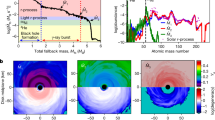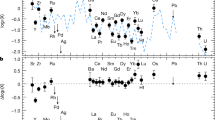Abstract
The rate of the triple-α reaction that forms 12C affects1,2 the synthesis of heavy elements in the Ga–Cd range in proton-rich neutrino-driven outflows of core-collapse supernovae3,4,5. Initially, these outflows contain only protons and neutrons; these later combine to form α particles, then 12C nuclei via the triple-α reaction, and eventually heavier nuclei as the material expands and cools. Previous experimental work6,7 demonstrated that despite the high temperatures encountered in these environments, the reaction is dominated by the well characterized Hoyle state resonance in 12C nuclei. At sufficiently high nucleon densities, however, proton- and neutron-scattering processes may alter the effective width of the Hoyle state8,9. This raises the questions of what the reaction rate in supernova outflows is, and how changes affect nucleosynthesis predictions. Here we report that in proton-rich core-collapse supernova outflows, these hitherto neglected processes enhance the triple-α reaction rate by up to an order of magnitude. The larger reaction rate suppresses the production of heavy proton-rich isotopes that are formed by the νp process3,4,5 (where ν is the neutrino and p is the proton) in the innermost ejected material of supernovae10,11,12,13. Previous work on the rate enhancement mechanism9 did not anticipate the importance of this enhancement for proton-rich nucleosynthesis. Because the in-medium contribution to the triple-α reaction rate must be present at high densities, this effect needs to be included in supernova nucleosynthesis models. This enhancement also differs from earlier sensitivity studies that explored variations of the unenhanced rate by a constant factor1,2, because the enhancement depends on the evolving thermodynamic conditions. The resulting suppression of heavy-element nucleosynthesis for realistic conditions casts doubt on the νp process being the explanation for the anomalously high abundances of 92,94Mo and 96,98Ru isotopes in the Solar System1,3,14 and for the signatures of early Universe element synthesis in the Ga–Cd range found in the spectra of ancient metal-poor stars15,16,17,18,19,20.
This is a preview of subscription content, access via your institution
Access options
Access Nature and 54 other Nature Portfolio journals
Get Nature+, our best-value online-access subscription
$29.99 / 30 days
cancel any time
Subscribe to this journal
Receive 51 print issues and online access
$199.00 per year
only $3.90 per issue
Buy this article
- Purchase on Springer Link
- Instant access to full article PDF
Prices may be subject to local taxes which are calculated during checkout





Similar content being viewed by others
Data availability
The simulation data that support these findings is available from the corresponding author upon reasonable request.
Code availability
The reaction network library SkyNet used for this work is publicly available at https://bitbucket.org/jlippuner/skynet. The code used to run and analyse the simulations described here (which relies on the SkyNet library) is publicly available at https://bitbucket.org/lroberts/triplealphainmediumenhancement.
References
Wanajo, S., Janka, H.-T. & Kubono, S. Uncertainties in the νp-process: supernova dynamics versus nuclear physics. Astrophys. J. 729, 46 (2011).
Nishimura, N. et al. Uncertainties in νp-process nucleosynthesis from Monte Carlo variation of reaction rates. Mon. Not. R. Astron. Soc. 489, 1379–1396 (2019).
Fröhlich, C. et al. Neutrino-induced nucleosynthesis of A > 64 nuclei: the νp process. Phys. Rev. Lett. 96, 142502 (2006).
Pruet, J., Hoffman, R. D., Woosley, S. E., Janka, H. T. & Buras, R. Nucleosynthesis in early supernova winds. II. The role of neutrinos. Astrophys. J. 644, 1028–1039 (2006).
Wanajo, S. The rp-process in neutrino-driven winds. Astrophys. J. 647, 1323–1340 (2006).
Fynbo, H. O. U. et al. Revised rates for the stellar triple-α process from measurement of 12C nuclear resonances. Nature 433, 136–139 (2005).
Freer, M. & Fynbo, H. O. U. The Hoyle state in 12C. Prog. Part. Nucl. Phys. 78, 1–23 (2014).
Truran, J. W. & Kozlovsky, B. Z. The enhancement of the 3 4He → 12C reaction rate in dense matter by inelastic-scattering processes. Astrophys. J. 158, 1021–1032 (1969).
Beard, M., Austin, S. M. & Cyburt, R. Enhancement of the triple alpha rate in a hot dense medium. Phys. Rev. Lett. 119, 112701 (2017).
Meyer, B. S., Mathews, G. J., Howard, W. M., Woosley, S. E. & Hoffman, R. D. r-process nucleosynthesis in the high-entropy supernova bubble. Astrophys. J. 399, 656–664 (1992).
Woosley, S. E. & Hoffman, R. D. The α-process and the r-process. Astrophys. J. 395, 202–239 (1992).
Hüdepohl, L., Müller, B., Janka, H. T., Marek, A. & Raffelt, G. G. Neutrino signal of electron-capture supernovae from core collapse to cooling. Phys. Rev. Lett. 104, 251101 (2010).
Fischer, T., Whitehouse, S. C., Mezzacappa, A., Thielemann, F. K. & Liebendörfer, M. Protoneutron star evolution and the neutrino-driven wind in general relativistic neutrino radiation hydrodynamics simulations. Astron. Astrophys. 517, A80 (2010).
Rayet, M., Arnould, M. & Prantzos, N. The p-process revisited. Astron. Astrophys. 227, 271–281 (1990).
Travaglio, C. et al. Galactic evolution of Sr, Y, and Zr: a multiplicity of nucleosynthetic processes. Astrophys. J. 601, 864–884 (2004).
Montes, F. et al. Nucleosynthesis in the early Galaxy. Astrophys. J. 671, 1685–1695 (2007).
Qian, Y. Z. & Wasserburg, G. J. Abundances of Sr, Y, and Zr in metal-poor stars and implications for chemical evolution in the early Galaxy. Astrophys. J. 687, 272–286 (2008).
Hansen, C. J., Montes, F. & Arcones, A. How many nucleosynthesis processes exist at low metallicity? Astrophys. J. 797, 123 (2014).
Eichler, M. et al. Nucleosynthesis in 2D core-collapse supernovae of 11.2 and 17.0 M☉ progenitors: implications for Mo and Ru production. J. Phys. G 45, 014001 (2018).
Bliss, J., Arcones, A. & Qian, Y. Z. Production of Mo and Ru isotopes in neutrino-driven winds: implications for solar abundances and presolar grains. Astrophys. J. 866, 105 (2018).
Angulo, C. et al. A compilation of charged-particle induced thermonuclear reaction rates. Nucl. Phys. A 656, 3–183 (1999).
Arcones, A. & Thielemann, F.-K. Neutrino-driven wind simulations and nucleosynthesis of heavy elements. J. Phys. G 40, 013201 (2013).
Hoffman, R. D., Woosley, S. E. & Qian, Y. Z. Nucleosynthesis in neutrino-driven winds. II. Implications for heavy element synthesis. Astrophys. J. 482, 951–962 (1997).
Wanajo, S., Müller, B., Janka, H.-T. & Heger, A. Nucleosynthesis in the innermost ejecta of neutrino-driven supernova explosions in two dimensions. Astrophys. J. 852, 40 (2018).
Davids, C. N. & Bonner, T. Enhancement of the 3 4He → 12C reaction rate by inelastic proton scattering. Astrophys. J. 166, 405–410 (1971).
Freer, M., Horiuchi, H., Kanada-En’yo, Y., Lee, D. & Meißner, U.-G. Microscopic clustering in light nuclei. Rev. Mod. Phys. 90, 035004 (2018).
Zimmerman, W. R. et al. Unambiguous identification of the second 2+ state in 12C and the structure of the Hoyle state. Phys. Rev. Lett. 110, 152502 (2013).
Zimmerman, W. R. Direct Observation of the Second 2+ State in 12C. PhD thesis, Univ. of Connecticut (2013).
Lippuner, J. & Roberts, L. SkyNet: a modular nuclear reaction network library. Astrophys. J. Suppl. Ser. 233, 18 (2017).
Timmes, F. X. & Swesty, F. D. The accuracy, consistency, and speed of an electron–positron equation of state based on table interpolation of the Helmholtz free energy. Astrophys. J. Suppl. Ser. 126, 501–516 (2000).
Cyburt, R. H. et al. The JINA REACLIB database: its recent updates and impact on type-I X-ray bursts. Astrophys. J. 189, 240–252 (2010).
Caughlan, G. R. & Fowler, W. A. Thermonuclear reaction rates V. At. Data Nucl. Data Tables 40, 283–334 (1988).
Arnold, C. W. et al. Cross-section measurement of 9Be(γ, n)8Be and implications for α + α + n → 9Be in the r process. Phys. Rev. C 85, 044605 (2012).
Radice, D. et al. Binary neutron star mergers: mass ejection, electromagnetic counterparts, and nucleosynthesis. Astrophys. J. 869, 130 (2018).
Roberts, L. et al. The influence of neutrinos on r-process nucleosynthesis in the ejecta of black hole-neutron star mergers. Mon. Not. R. Astron. Soc. 464, 3907 (2017).
Acknowledgements
We thank A. Arcones, J. Bliss, H. O. U. Fynbo, G. M. Hale, D. Lee and H. Weller for discussions. We acknowledge support from NSF awards PHY-1430152 (JINA Center for the Evolution of the Elements), PHY-1913554 and PHY-1102511. S.J. is supported by CSC-FRIB Postdoctoral Fellowship grant 201600090331. L.F.R. was partially supported by the US Department of Energy through the Advanced Computing (SciDAC) programme under award number DE-SC0017955.
Author information
Authors and Affiliations
Contributions
S.J. and L.F.R. carried out the calculations and analysis. S.M.A. carried out enhancement factor calculations. All authors contributed to the motivation, analysis and interpretation as well as the writing of the manuscript.
Corresponding author
Ethics declarations
Competing interests
The authors declare no competing interests.
Additional information
Peer review information Nature thanks the anonymous reviewer(s) for their contribution to the peer review of this work. Peer reviewer reports are available.
Publisher’s note Springer Nature remains neutral with regard to jurisdictional claims in published maps and institutional affiliations.
Supplementary information
Rights and permissions
About this article
Cite this article
Jin, S., Roberts, L.F., Austin, S.M. et al. Enhanced triple-α reaction reduces proton-rich nucleosynthesis in supernovae. Nature 588, 57–60 (2020). https://doi.org/10.1038/s41586-020-2948-7
Received:
Accepted:
Published:
Issue Date:
DOI: https://doi.org/10.1038/s41586-020-2948-7
This article is cited by
-
The 5α condensate state in 20Ne
Nature Communications (2023)
-
α-Clustering in atomic nuclei from first principles with statistical learning and the Hoyle state character
Nature Communications (2022)
-
Response functions of a 4π summing gamma detector in β-Oslo method
Nuclear Science and Techniques (2022)
-
Neutron-upscattering enhancement of the triple-alpha process
Nature Communications (2022)
-
\(\alpha\)-clustering effect on flows of direct photons in heavy-ion collisions
Nuclear Science and Techniques (2021)
Comments
By submitting a comment you agree to abide by our Terms and Community Guidelines. If you find something abusive or that does not comply with our terms or guidelines please flag it as inappropriate.



